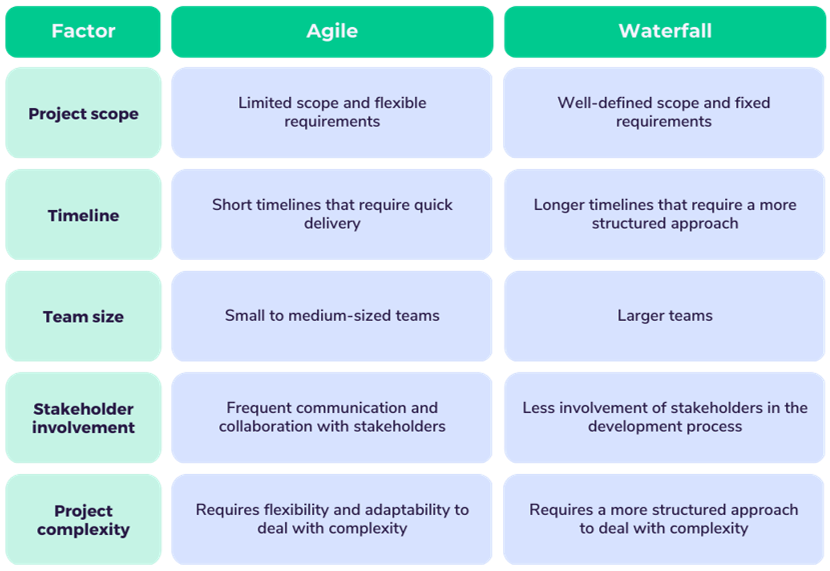Project management is an essential aspect of IT projects. As a project manager, you need to choose the right project management methodology for your IT project. Agile and Waterfall are two popular project management methodologies that have different strengths and weaknesses.
In this article, we will compare Agile vs. Waterfall project management and help you choose the right one for your IT project.
What is Agile project management?
Agile project management is designed to respond to the challenges of modern software development, where requirements can change frequently and rapidly.
It emphasizes flexibility and collaboration to ensure that software development teams can quickly adapt to changing requirements and deliver working software quickly.
By breaking down projects into smaller increments and iterating on development processes, Agile project management ensures that software development teams can deliver a functional product quickly while minimizing waste and maximizing value.
Key values of Agile Manifesto
Agile project management is based on the Agile Manifesto, which values several key aspects of the project development process.
Individuals and interactions
Working software
Customer collaboration
Responding to change
Agile project management process
If you’re looking to deliver software quickly and adapt to changing requirements, then Agile project management might be the right approach for your IT project.
The Agile project management process is based on iterative and incremental development, which allows for flexibility and adaptation throughout the Agile development process.
Iterations: In each iteration, the development team works on a set of requirements and delivers a working software increment.
Sprints: Sprints are short periods of time, usually one to four weeks, in which the development team works on a set of requirements.
Stand-up meetings: Stand-up meetings are daily meetings in which the development team discusses the progress of the project.
When to use the Agile methodology
Agile methodologies are best used when managing IT projects that require flexibility and adaptability. This approach is particularly effective for software development and mobile app development projects where requirements can change frequently. In general, Agile project management is most suitable for projects that have the following characteristics:
A scope that is not fully defined and can change during the development process
A project timeline that is short and requires quick delivery
A small to medium-sized development team that is cross-functional and self-organizing
Stakeholders that require frequent communication and collaboration throughout the development process
A complex and dynamic development process that requires flexibility and adaptability
When you have a project with changing requirements and a dynamic development process, using Agile project management can help you establish a collaborative and iterative approach to development.
Agile projects can provide more opportunities for stakeholder feedback and can improve overall project quality and customer satisfaction.
Additionally, using Agile can help your team adapt more quickly to changing requirements and improve overall project speed and efficiency.
What is Waterfall project management?
The Waterfall methodology is a traditional project management approach designed to provide a structured and controlled approach to project development.
This methodology assumes that all the requirements and specifications of the project are known upfront, and each phase of the project development process is completed in a specific order.
Since Waterfall is a plan-driven approach, it focuses on documentation and sign-offs to ensure that each phase of the project is completed according to plan before moving on to the next phase.
The rigid structure of the Waterfall methodology helps ensure that the project progresses in a predictable and controlled manner.
Phases of Waterfall project management
Waterfall project management is a traditional approach to project management that emphasizes structure and control. It is characterized by a linear and sequential progression through several key phases, with each phase fully completed before the next one can begin.
The Waterfall approach assumes that all the requirements and specifications of the project are known and defined upfront, and each phase of the project development process is completed in a specific order.
The key phases of Waterfall project management include:
Requirements gathering: The first phase of Waterfall project management is requirements gathering, which involves identifying the requirements for the project.
Design: The second phase of Waterfall project management is design, where the project design is developed based on the requirements gathered in the first phase.
Development: The third phase of Waterfall project management is development, where the project is built based on the design created in the previous phase.
Testing: The fourth phase of Waterfall project management is testing, which involves testing the project for quality and functionality.
Deployment: The final phase of Waterfall project management is deployment, where the project is implemented after it has been tested and approved.
When to use the Waterfall methodology
Waterfall project management is particularly effective for hardware development and infrastructure deployment where the project requirements are well-defined and less likely to change during the development process. In general, it is most suitable for projects that have the following characteristics:
A fixed and well-defined scope that is unlikely to change
A project timeline that is long and has limited flexibility
A large development team with well-defined roles and responsibilities
Stakeholders that have limited involvement in the development process
A straightforward and sequential development process with little complexity or uncertainty
Differences between Agile and Waterfall project management
The Agile and Waterfall methodologies have different strengths and weaknesses. Agile emphasizes flexibility, adaptability, and speed, while Waterfall emphasizes structure, predictability, and control. Here are some of the key differences between the two methodologies:
Approach: Agile is an iterative and incremental approach, while Waterfall is a linear and sequential approach.
Process: Agile emphasizes collaboration and communication, while Waterfall emphasizes documentation and sign-off.
Advantages and disadvantages: Agile is more flexible and adaptable, but it can be less predictable and more challenging to manage. Waterfall is more structured and predictable, but it can be less flexible and less responsive to change.
Factors to consider when choosing Agile or Waterfall for your IT project
Choosing the right methodology for your IT project depends on various factors. Here are some of the key factors to consider:
Project scope: The scope of your IT project will determine whether Agile or Waterfall is the best approach. Agile is suitable for projects with a limited scope and flexible requirements. Waterfall is suitable for projects with a well-defined scope and fixed requirements.
Timeline: The timeline of your IT project will determine whether Agile or Waterfall is the best approach. Agile is suitable for projects with short timelines that require quick delivery. Waterfall is suitable for projects with longer timelines that require a more structured approach.
Team size: The size of your software development team will determine whether Agile or Waterfall is the best approach. Agile is suitable for small to medium-sized teams, while Waterfall is suitable for larger teams.
Stakeholder involvement: The involvement of stakeholders in your IT project will determine whether Agile or Waterfall is the best approach. Agile is suitable for projects that require frequent communication and collaboration with stakeholders. Waterfall is suitable for projects where stakeholders are less involved in the development process.
Project complexity: The complexity of your software development project will determine whether Agile or Waterfall is the best approach. Agile is suitable for projects that require flexibility and adaptability to deal with complexity. Waterfall is suitable for projects that require a more structured approach to deal with complexity.

Conclusion
Agile and Waterfall project management methodologies are two popular options for IT project management. Agile emphasizes flexibility, adaptability, and speed, while Waterfall emphasizes structure, predictability, and control. Choosing the right methodology for your IT project depends on various factors, such as project scope, timeline, team size, stakeholder involvement, and project complexity.






